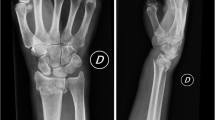Abstract
Introduction
The aim of this study was to determine whether an above-elbow cast (AEC) is better than a below-elbow cast (BEC) at maintaining the initial reduction in the orthopaedic management of a distal radius fracture (DRF).
Methods
It is a prospective randomized study carried out in a single emergency trauma department. There were 72 patients older than 55 years of age (55–96) with a distal radius fracture treated orthopaedically. They were randomized into two groups: group B (AEC 32 patients) and group A (BEC 40 patients). Randomization was done by a computer program. Four subgroups were constituted according to the instability criteria: subgroup 4 the most instable fractures. Main outcome was reduction loss from initial reduction to cast removal: it was measured using the volar tilt, radial tilt and radial length on plain radiographs.
Results
No differences were observed between group A and B when analysed globally (volar tilt loss p = 0.89 radial tilt loss p = 0.08 ulnar variance p = 0.19). Subgroups analysis revealed less radial tilt reduction loss in group A in patients within subgroup 3 (p = 0.02) and 4 (p = 0.003).
Discussion
Results are in contrast to what was expected. Limiting prono-supination AEC is supposed to better maintain initial fracture reduction. Effect of pronation and supination as well as distraction of brachioradialis muscle could have been overestimated until now.
Conclusion
The above-elbow cast is not better than the below-elbow cast in terms of loss reduction. However, the below-elbow cast more efficiently controls radial tilt reduction.


Similar content being viewed by others
References
Koval K, Haidukewych GJ, Service B, Zirgibel BJ (2014) Controversies in the management of distal radius fractures. J Am Acad Orthop Surg 2:566–575
Gehrmann SV, Windolf J, Kaufmann RA (2008) Distl radius fracture management in elderly patients: a literature review. J Hand Surg [Am] 33(3):421–429
Pool C (1973) Colles’s fracture: a prospective study of treatment. J Bone Joint Surg Br 55(3):540–544
Stewart HD, Innes AR, Burke FD (1984) Functional cast-bracing for Colles’ fractures: a comparison between cast-bracing and conventional plaster cast. J Bone Joint Surg Br 66(5):749–753
Bong MR, Egol KA, Leibman M, Koval KJ (2006) A comparison of immediate postreduction splinting construct for controlling initial displacement of fractures of the distal radius: a prospective randomized study of long-arm versus short-arm splinting. J Hand Surg 31A(5):766–770
Hendrickx RPM, Campo MM, Van Lieshout APW, Strijs PAA, Van Den Bekerom MPJ (2011) Above- or below-elbow casts for distal third forearm fractures in children? A meta-analysis of the literature. Arch Orthop Trauma Surg 131:1663–1671
Fernandez DL (2005) Closed manipulations and casting of distal radius fractures. Hand Clin 21:307–316
Leone J, Bhandari M, Adili A, McKenzie S, Moro JK, Dunlop RB (2004) Predictors of early and late instability following conservative treatment of extra-articular radius fractures. Arch Orthop Trauma Surg 124:38–41
Lafontaine M, Hardy D, Delince P (1989) Stability assessment of distal radius fractures. Injury 20:208–210
Medoff RJ (2005) Essential radiographic evaluation for distal radius fractures. Hand Clin 21:279–288
Pretell Mazzini J, Beck N, Brewer J, Baldwin K, Sankar W, Flynn J (2012) Distal metaphyseal radius fractures in children following closed reduction and casting: can loss of reduction be predicted? Int Orthop 36(7):1435–1440. doi:10.1007/s00264-012-1493-x
Handoll HHG, Madhok R (2003) Conservative interventions for treating distal radial fractures in adults. Cochrane Database Syst Rev 2:CD 000314
Makhni EC, Ewald TJ, Kelly S, Day CS (2008) Effect of patient age on the radiographic outcomes of distal radius fractures subject to nonoperative treatment. J Hand Surg 33A:1301–1308
Fujitani R, Omokawa S, Lida A, Santo S, Tanaka Y (2012) Reliability and clinical importance of teardrop angle measurement in intra-articular distal radius fracture. J Hand Surg 37A:454–459
Zhang B, Chang H, Yu K, Bai J, Tian D, Zhang G, Shao X, Zhang Y (2017) Intramedullary nail versus volar locking plate fixation for the treatment of extra-articular or simple intra-articular distal radius fractures: systematic review and meta-analysis. Int Orthop. doi:10.1007/s00264-017-3460-z
Author information
Authors and Affiliations
Corresponding author
Ethics declarations
Level of evidence
Therapeutic level I.
Ethical approval
All procedures performed in studies involving human participants were in accordance with the ethical standards of the institutional and/or national research committee and with the 1964 Helsinki declaration and its later amendments or comparable ethical standards.
Conflict of interests
On behalf of all authors, the corresponding author states that there is no conflict of interest.
Source of funding
All authors declare no conflict of interests including financial, consultant or institutional.
Rights and permissions
About this article
Cite this article
Gamba, C., Fernandez, F.A.M., Llavall, M.C. et al. Which immobilization is better for distal radius fracture? A prospective randomized trial. International Orthopaedics (SICOT) 41, 1723–1727 (2017). https://doi.org/10.1007/s00264-017-3518-y
Received:
Accepted:
Published:
Issue Date:
DOI: https://doi.org/10.1007/s00264-017-3518-y




